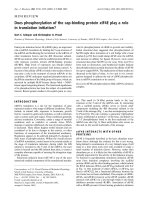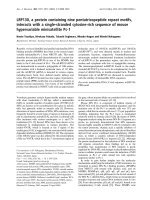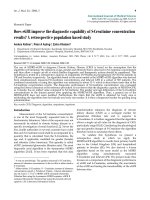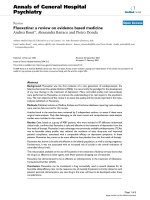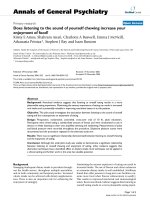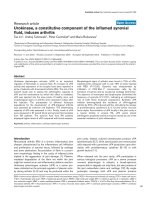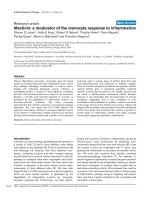Báo cáo y học: " Does a positive anti-CCP test identify a distinct arthritis entity" docx
Bạn đang xem bản rút gọn của tài liệu. Xem và tải ngay bản đầy đủ của tài liệu tại đây (37.41 KB, 3 trang )
230
ACPA = anti-citrullinated protein antibodies; CCP = cyclic citrullinated peptide; RA = rheumatoid arthritis; RF = rheumatoid factor; SE = shared
epitope.
Arthritis Research & Therapy December 2005 Vol 7 No 6 Skogh
Abstract
The introduction of tests recognizing ‘anti-citrullinated protein
antibodies’ (ACPA) has caused a revolution in rheumatology.
Immunization against citrullinated proteins is a feature almost
unique for rheumatoid arthritis, although ACPA may occur long
before the onset of symptoms. Even if the presence of ACPA does
not seem to reveal a distinct arthritis phenotype at symptom onset,
it predicts an aggressive disease course with unfavourable
outcome. Despite the very high diagnostic specificity for rheumatoid
arthritis, ACPA-positivity does not always accord with a traditional
diagnosis of rheumatoid arthritis at clinical presentation. However,
even when these patients are judged to suffer from mild
undifferentiated arthritis, they call for follow-up and special
attention by rheumatologists.
Introduction
A new era began when analyses identifying ‘anti-citrullinated
protein antibodies’ (ACPA) were introduced for the diagnosis
of arthritis. The question of whether ACPA-positive patients
constitute a distinct clinical entity presently attracts great
interest. In a previous issue of Arthritis Research and Therapy
Annette van der Helm-van Mil and colleagues give a detailed
description of clinical characteristics in very early rheumatoid
arthritis (RA) at presentation and during 4 years, comparing
patients with and without antibodies to cyclic citrullinated
peptide (CCP) [1].
ACPA constitute a growing family of autoantibodies, in which
the first member (anti-perinuclear factor) was described over
40 years ago. However, the major breakthrough came with the
important series of investigations by Walther van Venrooij and
colleagues, who discovered the crucial role of post-trans-
lationally citrullinated peptide epitopes and developed the anti-
CCP test. These workers also described the test’s remarkable
diagnostic specificity for RA, with a sensitivity comparable with
that for rheumatoid factor (RF) (reviewed in [2]).
Genes, environment and a pathogenetic
connection?
Although the aetiology is unknown, several genetic and
environmental factors are obviously important in RA. The
HLA-DRB1 product ‘shared epitope’ (SE) is the best known
genetic factor associated with RA, and cigarette smoking is
the best described environmental susceptibility factor. A
gene–environment interaction has been shown for SE and
smoking regarding susceptibility to RF-positive RA [3,4], and
the presence of anti-CCP antibodies (CCP+) correlates
strongly with the presence of the SE [5]. It has been
demonstrated that major histocompatibility complex class II
molecules expressing the SE can bind and present
citrullinated peptides to T cells [6], and that a combination of
SE-positive (SE+) and CCP+ is highly predictive of future
RF-positive RA [7]. Contrary to nonsmokers, bronchoalveolar
lavage cells from cigarette smokers have been reported to
express citrullinated antigens [8]. It was also recently
reported that smoking is a risk factor to develop CCP+ RA
only in SE+ patients [4,8].
Taken together, these observations suggest that immuniza-
tion against citrullinated antigens in SE+ persons, possibly
after triggering by nonspecific adjuvants such as cigarette
smoke, may be critical for the initiation of RA. Serum levels of
anti-CCP antibodies do not correlate with disease activity,
however – although they often drop after institution of
disease-modifying anti-rheumatic drugs, at least in RA of
short duration [9-11].
Rheumatoid factor versus ACPA in RA
The RF described by Erik Waaler in 1937 is a family of
agglutinating antibodies against different epitopes on the Fc
part of rabbit IgG exposed on the surface of sheep
erythrocytes. The Waaler–Rose haemagglutination assay was
Commentary
Does a positive anti-CCP test identify a distinct arthritis entity?
Thomas Skogh
Division of Rheumatology/AIR, Department of Molecular and Clinical Medicine, Faculty of Health Sciences, Linköping University Hospital, Linköping,
Sweden
Corresponding author: Thomas Skogh,
Published: 16 September 2005 Arthritis Research & Therapy 2005, 7:230-232 (DOI 10.1186/ar1836)
This article is online at />© 2005 BioMed Central Ltd
See related research by van der Helm-van Mil et al. in issue 7.5 [ />231
Available online />the prevailing method to analyse RF during the following
50 years, but many additional methods have been developed,
including different latex particle agglutination assays and
isotype-specific enzyme immunoassays using various sources
of IgG as antigen (e.g. human, rabbit, horse).
In the 1987 revised American College of Rheumatology
classification criteria for RA, a positive RF test is defined by a
cutoff level at the 95th percentile in ‘normal control subjects’.
In practice this means that up to 5% of middle-aged healthy
blood donors, and considerably more patients with non-RA
inflammatory disease, can be expected to have a positive RF
test. Increasing the cutoff limit increases the diagnostic
specificity for RA, but decreases the sensitivity. The 1987
American College of Rheumatology criteria accept ‘any
method’ to analyse RF, thus including antibodies of any
isotype (agglutinating or not) and including reactivity to
different epitopes on IgG-Fc, such as heterophilic antibodies
against nonhuman species.
Despite access to an international reference serum, there is
an obvious lack of standardization regarding RF analyses,
which makes it difficult to compare the relevance of different
studies on ‘seropositive’ RA and ‘seronegative’ RA. Reports
on ACPA prevalence rates in RA also vary depending on the
choice of analytical method and on the study population. At a
diagnostic sensitivity equal to agglutinating RF, the second-
generation anti-CCP2 assays detect ACPA of the IgG class
with a superior diagnostic specificity for RA. Studies on
patients with longstanding RA have shown substantially
higher prevalence rates of positive anti-CCP tests [2] than
investigations based on patients with very early RA [1]. On
the other hand, there is no evidence suggesting that the
ACPA prevalence increases with increasing disease duration.
Prospective studies on early RA have shown that the anti-
CCP status is usually stable from the time of clinical
presentation, although the average antibody levels decrease
after diagnosis, probably due to medication [9-11]. The lower
prevalence rates recorded in incident population-based
materials of very early arthritis are probably due to the fact
that these study populations comprise patients having milder
disease with more favourable outcome compared with
selected prevalent cases with longstanding disease.
Anti-CCP antibodies versus clinical
presentation, disease course and outcome
The article by van der Helm-van Mil and colleagues gives a
detailed description of the synovitis pattern in very early RA
and a rating of the synovitis magnitude from baseline to the
4-year follow-up [1]. They found that clinical characteristics
were similar in CCP+ patients and in patients without
antibodies to CCP (CCP– patients) at baseline, and that the
patterns of joint affection were similar during the 4-year
follow-up. However, a less favourable disease course was
recorded in the CCP+ patient group both regarding the
degree of synovitis and joint destruction. One-half of the
patient population was initially treated with analgesics
followed by antimalarials or sulfasalazine if the initial treatment
was insufficient, and the other half of the population was
immediately given methotrexate or sulfasalazine. However,
detailed information on prescription patterns in CCP+
patients versus CCP– patients is lacking.
In three Swedish prospective studies on early RA, disease
progression was compared between CCP+ cases and
CCP– cases [5,9,10]. Although they had similar baseline
characteristics, two of the studies recorded signs of higher
disease activity in the CCP+ patients already at presentation
[5,9], and in all three studies a more aggressive disease with
unfavourable outcome was seen in these patients. In the
study by Kastbom and colleagues, the physicians’ higher
scoring of global disease activity probably explains the higher
preparedness to use potent disease-modifying anti-rheumatic
drugs in CCP+ patients from presentation throughout the
3-year follow-up period [9]. However, the discrepant results
between the different studies regarding disease activity and
severity in CCP+ versus CCP– cases should not be
exaggerated. They may be explained by factors such as
different disease durations at the study start and different
treatment strategies. Numerous studies have shown that
ACPA are not only highly specific markers of present (and
future) RA, but are also predictors of poor outcome. Different
ACPA tests are not interchangeable, however, since they
differ regarding diagnostic sensitivity, specificity, and
prediction of disease course/outcome [2]. The anti-CCP
assays available today offer a good opportunity to introduce
well-standardized analysis of a highly disease-specific test for
routine diagnosis of RA.
Anti-CCP, rheumatoid factor or both?
It is probable that antibodies against citrullinated proteins will
be included among future classification/diagnostic criteria for
RA. Nevertheless, RF is still a classification criterion and,
despite shortcomings regarding epitope specificity, standard-
ization, and disease specificity, it continues to be a valuable
diagnostic tool in rheumatology. However, RF analysis must
not be exploited as a screening instrument for patients with
aches and pains without signs of synovitis or systemic
inflammation. Such abuse results in a high ‘noise ratio’ of
patients with noninflammatory disease without the need for
costly referrals to rheumatologists. For nonrheumatologists
who are not experienced in joint examination, anti-CCP
antibody testing offers a better standardized primary option
with a similar sensitivity for RA, but with a superior specificity
of established or future disease. However, a few RF-positive
cases as well as most RF-negative cases will be missed.
Therefore, regardless of serological status, a patient with
clinical signs of synovitis in multiple joints should obviously be
referred to a rheumatologist despite a negative anti-CCP test.
As with all new diagnostic tests, it will take time to learn how
to cope rationally with positive anti-CCP tests in clinical
232
Arthritis Research & Therapy December 2005 Vol 7 No 6 Skogh
practice. Certainly, we will identify early cases of anti-CCP+
non-RA, referring to the present American College of
Rheumatology classification criteria. Although some anti-
CCP+ early arthritis patients may be judged to have mild
undifferentiated arthritis, it is imperative that rheumatologists
keep an eye on these cases in order to achieve a balanced
and solid experience, to monitor disease progression, and to
be prepared to institute potent anti-rheumatic treatment
before it is too late.
Conclusions
The ACPA era has just begun, but has already proved to be a
revolution in rheumatology. Although a positive anti-CCP test
does not appear to identify patients with distinct clinical
characteristics at presentation, it is superior to RF regarding
diagnostic specificity for RA, and the anti-CCP test predicts
more severe disease course and outcome.
Competing interests
The author(s) declare that they have no competing interests.
References
1. van der Helm-van Mil AHM, Verpoort KN, Breedveld FC, Toes
REM, Huizinga TWJ: Antibodies to citrullinated proteins and
differences in clinical progression of rheumatoid arthritis.
Arthritis Res Ther 2005, 7:R949-R958.
2. Nijenhuis S, Zendman AJ, Vossenaar ER, Pruijn GJM, van Venrooij
WJ: Autoantibodies to citrullinated proteins in rheumatoid
arthritis: clinical performance and biochemical aspects of an
RA-specific marker. Clin Chim Acta 2004, 350:17-34.
3. Padyukov L, Silva C, Stolt P, Alfredsson L, Klareskog L: A
gene–environment interaction between smoking and shared
epitope genes in HLA-DR provides a high risk of seropositive
rheumatoid arthritis. Arthritis Rheum 2004, 50:3085-3092.
4. Linn-Rasker SP, van der Helm-van Mil AHM, van Gaalen FA, Klop-
penburg M, De Vries R, le Cessie S, Breedveld FC, Toes REM,
Huizinga TWJ: Smoking is a risk factor for anti-CCP antibodies
only in RA patients that carry HLA-DRB1 shared epitope
alleles. Ann Rheum Dis 2005 [Epub ahead of print].
5. Forslind K, Ahlmen M, Eberhardt K, Hafstrom I, Svensson B: Pre-
diction of radiological outcome in early rheumatoid arthritis in
clinical practice: role of antibodies to citrullinated peptides
(anti-CCP). Ann Rheum Dis 2004, 63:1090-1095.
6. Hill JA, Southwood S, Sette A, Jevnikar AM, Bell DA, Cairns E:
Cutting edge: the conversion of arginine to citrulline allows
for a high-affinity peptide interaction with the rheumatoid
arthritis-associated HLA-DRB1*0401 MHC class II molecule.
J Immunol 2003, 171:538-541.
7. Berglin E, Padyukov L, Sundin U, Hallmans G, Stenlund H, Van
Venrooij WJ, Klareskog L, Dahlqvist SR: A combination of
autoantibodies to cyclic citrullinated peptide (CCP) and HLA-
DRB1 locus antigens is strongly associated with future onset
of rheumatoid arthritis. Arthritis Res Ther 2004, 6:R303-R308.
8. Klareskog L, Stolt P, Lundberg K, Källberg H, Bengtsson C,
Grünewald J, Rönnelid J, Erlandsson Harris H, Ulfgren AK,
Rantapää-Dahlqvist S, et al.: A new model for an etiology of RA:
smoking may trigger HLA-DR (SE)-restricted immune reac-
tions to autoantigens modified by citrullination. Arthritis
Rheum 2005, in press.
9. Kastbom A, Strandberg G, Lindroos A, Skogh T: Anti-CCP anti-
body test predicts the disease course during 3 years in early
rheumatoid arthritis (the Swedish TIRA project). Ann Rheum
Dis 2004, 63:1085-1089.
10. Rönnelid J, Wick MC, Lampa J, Lindblad S, Nordmark B, Klareskog
L, van Vollenhoven R: Longitudinal analysis of anti-citrullinated
protein/peptide antibodies (anti-CP) during 5 year follow-up in
early rheumatoid arthritis: anti-CP status is a stable phenotype
that predicts worse disease activity and greater radiological
progression. Ann Rheum Dis 2005 [Epub ahead of print].
11. Mikuls TR, O’Dell JR, Stoner JA, Parrish LA, Arend WP, Norris JM,
Holers VM: Association of rheumatoid arthritis treatment
response and disease duration with declines in serum levels
of IgM rheumatoid factor and anti-cyclic citrullinated peptide
antibody. Arthritis Rheum 2004, 50:3776-3782.


